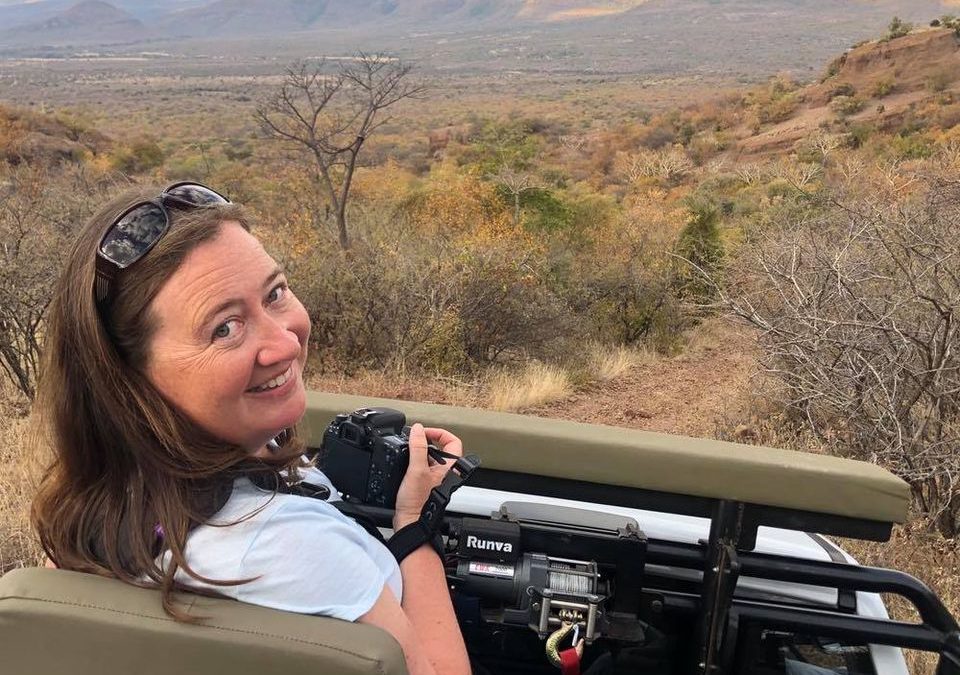
by Carrie Stevenson | Aug 27, 2020
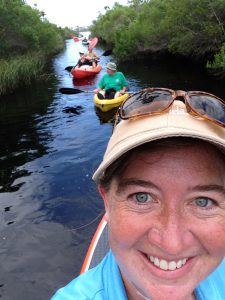 Carrie Stevenson is the Coastal Sustainability Agent for the UF/IFAS Escambia County Extension Office, and has been with the organization almost 17 years. Her educational outreach programs focus on living sustainably within a vulnerable coastal ecosystem. She helps clientele better understand how to protect and preserve local ecosystems and water resources, wisely use our abundant rainfall and sunlight, and prepare and mitigate for flooding, coastal storms and climate impacts.
Carrie Stevenson is the Coastal Sustainability Agent for the UF/IFAS Escambia County Extension Office, and has been with the organization almost 17 years. Her educational outreach programs focus on living sustainably within a vulnerable coastal ecosystem. She helps clientele better understand how to protect and preserve local ecosystems and water resources, wisely use our abundant rainfall and sunlight, and prepare and mitigate for flooding, coastal storms and climate impacts.
Growing up an avid reader and science junkie, a young Carrie aspired to find a career that allowed her to “be outdoors and wear jeans,” and in college sought to become a science writer. When National Geographic didn’t come calling, she found a position as a field-based environmental specialist with the Florida Department of Environmental Protection. There, she handled compliance and enforcement cases related to stormwater and wetlands, spending days tromping through the swamps, wet prairies, and newly built subdivisions of northwest Florida. After joining UF IFAS Extension, she spent 6 years as a Florida Yards & Neighborhoods Agent before switching to Coastal Sustainability. Her expertise and articles focus on climate issues, stormwater, hurricanes, native plants, and wetlands.
A lifelong outdoors enthusiast, she enjoys biking, standup paddleboarding, and traveling to national parks with her family. She also has many favorite international outdoor experiences, ranging from hiking glaciers in Canada to snorkeling coral reefs in Belize and watching elephants drink from a South African river. A native of Mississippi, Carrie has lived with her husband in Pensacola since 1999. Carrie earned her master’s degree in Biology/Coastal Zone Studies from the University of West Florida in Pensacola and an undergraduate degree in Marine Science from Samford University (Birmingham, Alabama). She is the proud mom of an Eagle Scout and leads her daughter’s Girl Scout troop. She is a Fellow in the Natural Resources Leadership Institute (NRLI), past president of the Florida Association of Natural Resource Extension Professionals (FANREP), and member of IMPACT 100 Pensacola Bay.
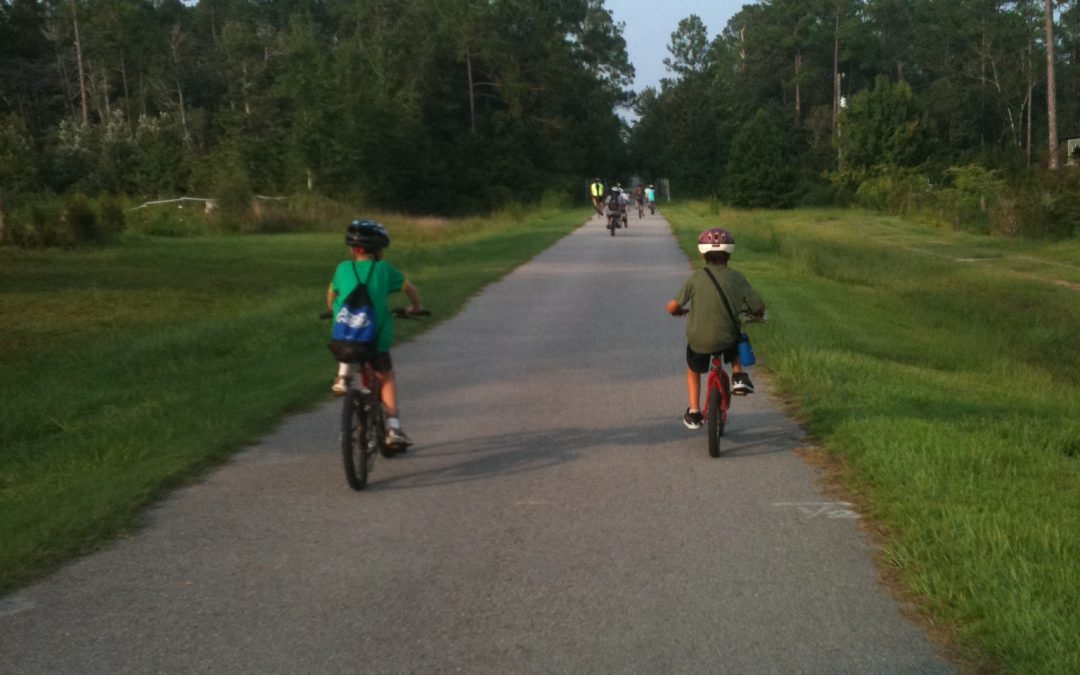
by Carrie Stevenson | May 29, 2020
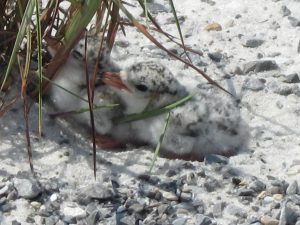
Baby terns on Pensacola Beach are camouflaged in plain sight on the sand. This coloration protects them from predators but can also make them vulnerable to people walking through nesting areas. Photo credit: UF IFAS Extension
The controversial incident recently in New York between a birdwatcher and a dog owner got me thinking about outdoor ethics. Most of us are familiar with the “leave no trace” principles of “taking only photographs and leaving only footprints.” This concept is vital to keeping our natural places beautiful, clean, and safe. However, there are several other matters of ethics and courtesy one should consider when spending time outdoors.
- On our Gulf beaches in the summer, sea turtles and shorebirds are nesting. The presence of this type of wildlife is an integral part of why people want to visit our shores—to see animals they can’t see at home, and to know there’s a place in the world where this natural beauty exists. Bird and turtle eggs are fragile, and the newly hatched young are extremely vulnerable. Signage is up all over, so please observe speed limits, avoid marked nesting areas, and don’t feed or chase birds. Flying away from a perceived predator expends unnecessary energy that birds need to care for young, find food, and avoid other threats.
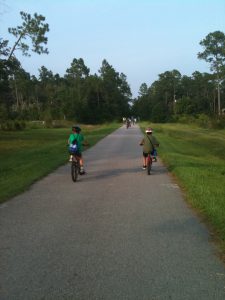
When on a multi-use trail, it is important to use common courtesy to prevent accidents. Photo credit: Carrie Stevenson, UF IFAS Extension
- On a trail, the rules of thumb are these: hikers yield to equestrians, cyclists yield to all other users, and anyone on a trail should announce themselves when passing another person from behind.
- Obey leash laws, and keep your leash short when approaching someone else to prevent unwanted encounters between pets, wildlife, or other people. Keep in mind that some dogs frighten easily and respond aggressively regardless of how well-trained your dog is. In addition, young children or adults with physical limitations can be knocked down by an overly friendly pet.
- Keep plenty of space between your group and others when visiting parks and beaches. This not only abides by current health recommendations, but also allows for privacy, quiet, and avoidance of physically disturbing others with a stray ball or Frisbee.
Summer is beautiful in northwest Florida, and we welcome visitors from all over the world. Common courtesy will help make everyone’s experience enjoyable.
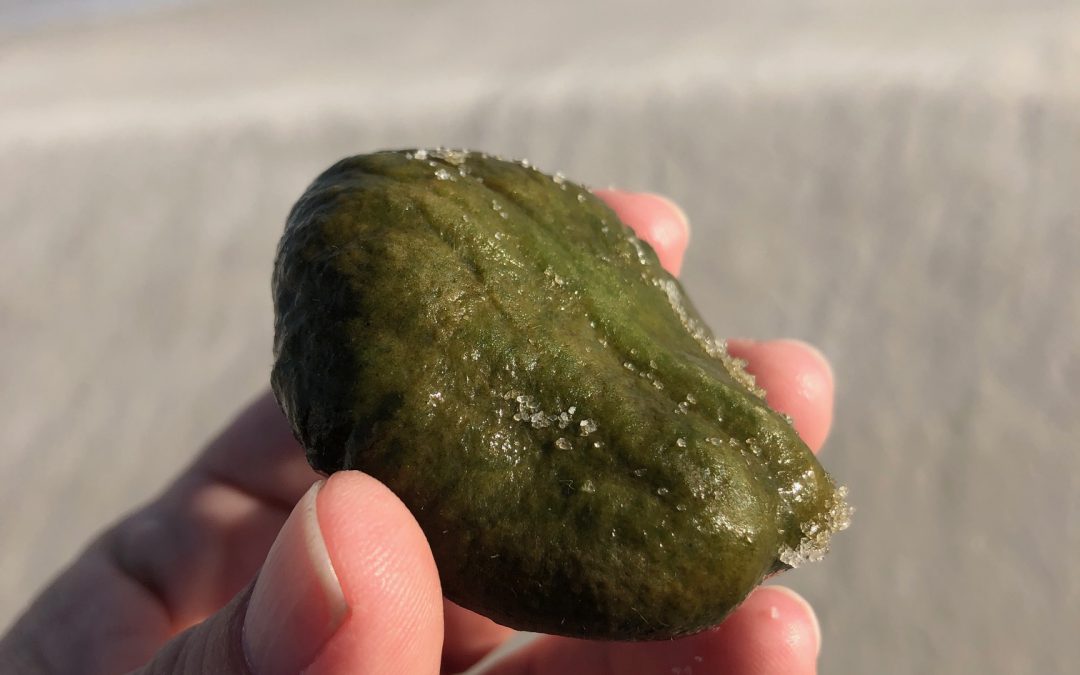
by Carrie Stevenson | May 22, 2020
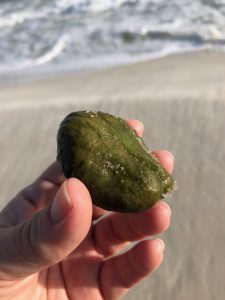
Sea pork comes in a wide variety of shapes and sizes. Photo credit: Carrie Stevenson, UF IFAS Extension
Recently I was walking the beach, enjoying a sunset and looking around at the shells and other oddities in the wrack line where waves deposit their floating treasures. Something bright green and oblong caught my eye. It was emerald in color, smooth yet fuzzy at the same time, and firm to the touch. At first, I thought it was a sea bean–a collective term for the many species of seeds and fruits that float to our shores from tropical locations in the Caribbean or Central/South America. The bright green definitely seemed like something botanical in nature. However, the vast majority of sea beans have a woody, protective shell similar to our more familiar pecans or acorns.
I remembered a family member asking about finding a mystery chunk of pink mass she found on the beach a few years ago. It resembled a pork chop more than anything else.
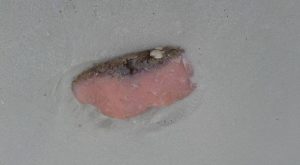
A different variety of sea pork that really lives up to its name. Photo credit: Stephanie Stevenson, Duval County Master Gardener
Looking closer and consulting a couple of resources, I realized we had both (most likely!) happened upon one of the oddest and often-questioned finds on our beaches: sea pork. Ranging in color from beige and pale pink to red or green, sea pork is a tunicate (or sea squirt), a member of the Phylum Chordata, home to all the vertebrate and semi-vertebrate animals. While they look and feel more like a cross between invertebrate slugs or sponges, the tunicates are more advanced organisms, possessing a primitive backbone in their larval “tadpole” form. Despite their blob-like appearance, they are more closely related to vertebrate animals than they are to corals or sponges.
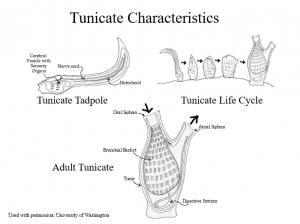
The unusual life cycle of the tunicate. Photo credit: University of Washington, used with permission with Florida Master Naturalist program
During their short (just hours-long) larval stage, the tunicate larvae uses its nerve cord (supported by a notochord similar to a vertebrate spine) to communicate with a cerebral vesicle, which works like a brain. Similar to fish, this primitive brain uses an otolith to orient itself in the water, and an eyespot to detect light. These brain-like tools are utilized to locate an appropriate location to settle permanently. Using a sticky substance, the tunicate will attach its head directly to a hard surface (rocks, boats, docks, etc.) and go through a metamorphosis of sorts. The tunicate reabsorbs its tail and starts forming the shape and structure it needs for adulthood.
As an adult, the organism has a barrel shape covered by a tough tunic-like skin (hence “tunicate”). Adult bodies have two siphons, one to bring water in, another to shoot it out (giving them their other nickname, the sea squirt). The water passes through an atrium with organs that allow it to filter feed, trapping plankton and oxygen. The tunicates will spend most of their lives attached to a surface, pumping water in and out as filter feeders. They may be solitary or live in colonies, and vary widely in color and shape, lending variety to those chunks of sea pork found washing up.
I am still awaiting positive identification from an expert on my green find to confirm that it is, indeed, a tunicate and not an unfamiliar plant. Consulting with Extension colleagues, for now we are pretty confidently going with green sea pork. If you have seen one of these before or something resembling sea pork, let us know! It is fascinating to see the variety and unusual shapes and colors.
.
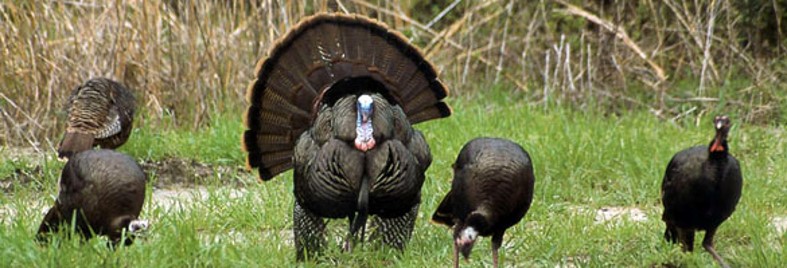
by Shep Eubanks | Mar 27, 2020

Wild Turkeys in Chufa planted in Gadsden County – Photo by Shep Eubanks UF IFAS
Wildlife management continues to be an area of growing interest on our local farms and ranches and has the potential to generate significant additional income to the farm enterprise. It is also an opportunity to practice good stewardship of the natural resources that we have in abundance here in the Panhandle. Each spring I get many phone calls from landowners wanting to know what they can plant to encourage wild turkeys to utilize their property more and to enhance the quality of their wild turkey habitat. Chufa is one such plant that wild turkeys love like most of us love ice cream and it is easy to grow and will provide feed for turkeys for several months.
What is chufa? Chufa is an African variety of the native nutsedge, which is a warm season perennial plant. However, chufa is not as aggressive as the native nutsedges and typically will not create problems with succeeding crops that you might plant after it. The actual foliage of the plant is not utilized by wildlife, but turkeys, hogs, ducks, and raccoons love the underground tubers that the plant produces. Each individual plant can produce 10 to 75 peanut kernel sized tubers (see photo 1) that wildlife utilize. These tubers are high in carbohydrates and protein, and they are also edible by humans, having a sweet taste similar to almonds or raw peanuts.

Photo 1. Chufa seed for planting – Photo by Shep Eubanks UF IFAS
Turkeys will usually begin to dig the chufas up in early fall as soon as the above ground leaves turn brown. In Florida, they will dig and eat the nuts from fall throughout the winter and into spring. (see photo 2 of turkeys feeding in a spring chufa patch)

Photo 2. Turkeys scratching up chufas – Photo by Shep Eubanks UF IFAS
If you are considering planting chufa there are several considerations to take into account. The chufa plant typically grows well anywhere that field corn can be grown. You should soil test the area you intend to plant and lime to a pH between 6.0 – 6.5. On most soils this requires 1 ton of lime per acre. Recommended planting dates are April 1st through June 30th in the panhandle area. Earlier plantings will provide higher yields, whereas later plantings typically will provide foraging for wildlife later into the following spring. To maximize use by turkeys into the spring I would recommend looking at planting in June. Chufa can be planted later than June 30th some years but remember that it takes the plant approximately 90 days to produce mature tubers and this must be accomplished prior to frost/cold weather. Plant the seed into a well prepared and fertilized seedbed. The seeding rate for chufa is 40 – 50 pounds per acre broadcast or 30 pounds per acre drilled on a 36 inch row spacing. Strive for a coverage of 3 or 4 seed per square foot. When broadcasting the seed, set your disk to cut about 4 inches deep. This will cover the seed to an approximate depth of 2 inches which is ideal for chufa. Normal fertilizer recommendations would be 200 pounds of 17-17-17 per acre or equivalent at planting. When the plants are 6 – 12 inches high (approximately 1 month old) you should top dress with 100 pounds of actual N per acre (300 pounds of ammonium nitrate) to maximize yields. With high costs of fertilizer this may not be as desirable, but yields will be smaller if fertilizer rates are reduced. For weed control options on chufa plantings consult with your local County Extension Agent for up-to-date recommendations.
Small plantings are feasible (less than ¼ acre) if wild hogs are not present. It has been my experience that best results are obtained with ½ acre or larger plantings. Chufa is a plant that will do a good job of reseeding itself, sometimes for several years. Reseeding can be accomplished by simply disking the area of the previous planting between April and the end of June and following fertilizer recommendations for the initial planting. For most locations it is advisable to move the chufa plot to a different location after the second crop to avoid problems with soil pests. (see photo 3 of typical planting).
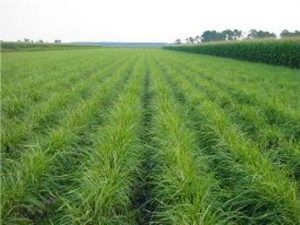
Photo 3. Chufa planting – Photo by Shep Eubanks UF IFAS
If you have never planted chufas before for your turkeys, you may want to pull some up or disk a row up in the fall after the tops have died back. This will assist the turkeys in finding the plants if they have never encountered it before. Once they do find it you can expect to find tremendous areas of scratching. Quite often the plots will literally look like a mortar or bombing range where the turkeys dig down to get the chufas!
For more information consult with your local Extension Agent .

by Shep Eubanks | Nov 14, 2019
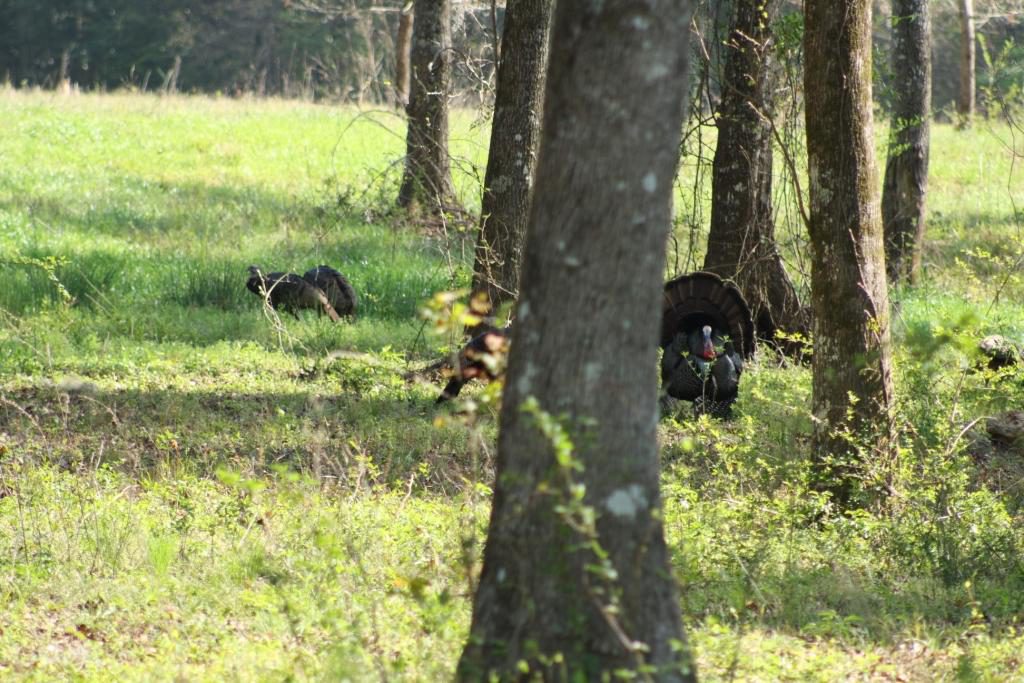
Eastern Wild Turkey Gobbler in Gadsden County – photo by Shep Eubanks UF/IFAS
The above picture of a strutting Eastern Wild Turkey is a sight that many hunters look forward to seeing every spring here in the panhandle of Florida. In order to manage wild turkeys and their habitat it is good to understand some basic facts about their biology.
Wild turkeys are considered a generalist species, meaning that they can eat a wide variety of foods, primarily seeds, insects, and vegetation. They prefer relatively open ground cover so that they can see well and easily move through their surroundings, but they aren’t picky about where they live as long as it provides them year-round groceries and safety. They are also a very adaptable species. Turkeys prefer low, moderately open herbaceous vegetation (less than three feet in height) that they can see through, or see over, and through which they can easily move in relatively close proximity to forested cover. Such open habitat conditions help them see and avoid predators and these areas will typically provide sufficient food in terms of edible plants, fruit, seeds, and insects.
Wild turkeys are considered, ecologically, to be a “prey species” and have evolved as a common food source for numerous animals—seems everything is trying to eat them. Turkey eggs, young (i.e.,poults), and adults are preyed on by such animals as bobcats, raccoons, skunks, opossum, fox , coyotes, armadillos, crows, owls, hawks, bald eagles, and a variety of snakes. Being prey to so many different animals has shaped the turkey’s biology and behavior. Turkeys experience high mortality rates and don’t live very long, on average, <2 years. They are particularly vulnerable during nesting and immediately after hatching. Because of this high mortality, reproduction is really important for turkey populations to replace the individuals that don’t survive from year to year. Wild turkeys have adapted to being a prey species in part, though, by having a high reproductive potential. Hens have the capacity to lay large clutches of eggs. If a nest is destroyed or disturbed, especially during the egg laying or early incubation period, the hen will often re-nest. Turkeys are also polygamous, with males capable of breeding multiple females, which further boosts their reproductive potential.
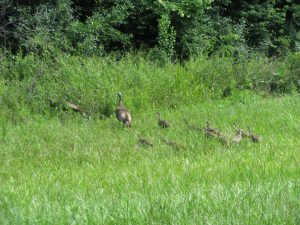
Turkey hen with poults foraging in a grassy field in Gadsden County – photo by Shep Eubanks UF/IFAS
Newly hatched turkeys, referred to as poults, need grassy, open areas so they can find an abundance of insects. Such areas are usually the most critical, and often the most lacking habitat in Florida. Under ideal conditions for turkeys, grassy openings would occupy approximately 25 percent of a turkey’s home range. Additionally, it is of equal importance to have such openings scattered throughout an area, varying in size from 1 to 20 acres such that they are small, or irregular in shape, to maximize the amount of adjacent escape cover (moderately dense vegetation or forested areas that can provide concealment from predators or other disturbances). Large, expansive openings (e.g., large pastures) without any escape cover are not as useful for turkeys since they generally will not venture more than 100 yards away from suitable cover.
Good habitat allows turkeys to SEE approaching danger and to MOVE unimpeded (either to move away from danger or simply to move freely while foraging without risk of ambush). In other words, good habitat provides the right vegetative structure. When thinking about habitat for turkeys, it’s good to always think from a turkey’s point of view….about 3 feet off the ground! Turkeys like open areas where they can see well and easily move.
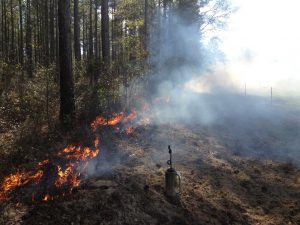
Burning pine land in Gadsden County to improve wild turkey habitat – photo by Shep Eubanks UF/IFAS
One of the best management techniques to manage vegetation structure and composition is prescribed fire. Fire can be very destructive, but if properly applied, fire can be quite beneficial to wildlife and is one of the best things you can do for wild turkeys. When applied correctly, fire has many benefits. Some of the benefits of fire to turkeys and other wildlife include: control of hardwood by setting back woody shrubs and trees in the under story; improving vegetation height and structure; stimulating new herbaceous growth at ground level; stimulating flowering and increased fruit production in some plants; it improves nutritional value and increases palatability of vegetation. All of this leads to increased insect abundance and fewer parasites in the environment. Prescribed fire also has benefits for the landowner. Applied properly and regularly, prescribed fire will reduce risk of catastrophic wildfire which can destroy a timber stand. It reduces hardwood competition so favored pines grow faster and healthier; and reduces the risk of disease, particularly after a thinning or timber cut, by removing logging debris that would otherwise attract insects and disease-causing agents. It can also help control invasive species, and best of all it’s the least expensive option on a cost per acre basis.

Gobblers in pine stand after burn – Game Camera photo by Shep Eubanks
Another good practice is simply mowing or bush-hogging. Even in areas that aren’t super thick (such as around forest and field edges, or seasonal wetlands), mowing and bush-hogging alone, even without fire, are beneficial as they have much the same effect on the habitat as fire. Basically, you’re removing grown up vegetation and allowing light to reach the ground again. Within pine plantations, roads often provide some of the best, or only, turkey habitat simply because the surrounding vegetation becomes too dense so roads are used for feeding and moving throughout the area. In this regard, wide roads increase the amount of open habitat which provides lots of insects, seeds, and edible vegetation. They also reduce the opportunity for predators to ambush turkeys which can readily occur on narrow roads. Having wide roads is a good land management practice that lets roads dry-out quicker so that they can hold up to traffic better.
If you have pine dominated timber stands on your property, proper thinning is not only good for turkeys, but it’s good for your stand. Young pine stands, particularly those in sapling or early pole stages, are often too thick for wild turkeys, except as escape cover. They get so dense that they shade out everything underneath. They may produce some pine seeds when they get older, but for most of the year, there’s nothing to eat and nothing to attract turkeys to the area. For turkeys, thinning opens up the canopy and allows sunlight to reach the forest floor, which in turn stimulates plant growth of grasses, forbs and soft-mast producing shrubs.
If you have an interest in turkeys, do most management activities outside of the nesting season, which generally runs from the middle of March through June. From a practical standpoint that is not always possible, so on the positive side, if a nest is destroyed (whether by predators or management efforts), a hen will quite often re-nest. Also, the overall importance of management will often outweigh the loss of 1 or 2 nests. The time that turkey nests are at a premium is when a turkey population is low or just trying to get established into an area. In such cases every nest is valuable.
For more information consult with your local Extension Agent .
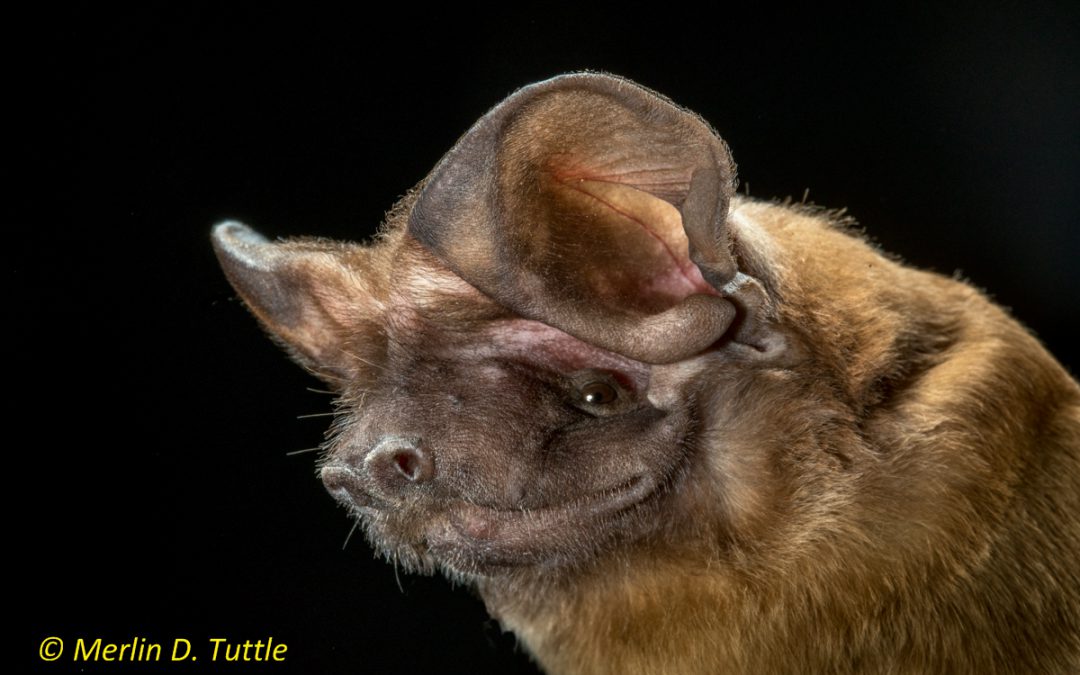
by hollyober | Nov 9, 2018
The week prior to Halloween is officially designated as National Bat Week. In honor of this event, it’s worth considering some of the benefits bats provide to us.
Did you know there is a species of bat that lives nowhere in the world but within our state? It’s called the Florida Bonneted Bat, and occurs in only about 12-15 counties in south and central FL. These bats are so mysterious that we’re currently not even sure exactly where they occur. They are so rare that they’re listed as a federally endangered species.
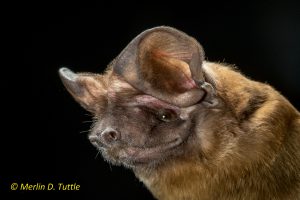
The Florida Bonneted Bat lives nowhere in the world but Florida. Photo credits: Merlin Tuttle.
These bats were named for their forward-leaning ears, which they can tilt forward to cover their eyes. With a wingspan of 20 inches, they are the largest bats east of the Mississippi River: only two U.S. species are larger than they are, and these both occur out west.
We have been investigating the diet of Florida Bonneted Bats. To do this, we captured bats in specialized nets, and then collected their scat (called guano). Next, we processed the scat in a laboratory using DNA metabarcoding to determine which insect species the bats had recently consumed.
We found that the bats eat several economically important insects, including the following:
- fall armyworm (Spodoptera frugiperda)
- lesser cornstalk borer (Elasmopalpus lignosellus)
- tobacco hornworm (Manduca sexta)
- black cutworm (Agrotis ipsilon)
These insects are pests of corn, cotton, peanut, soybean, sorghum, tobacco, tomato, potato, and many other crops.
Furthermore, the bats did not eat these insect pests infrequently. In fact, 86% of the samples we examined contained at least one pest species. On average, each sample contained three pest species! This tells us that Florida Bonneted Bats should be considered IPM (Integrated Pest Management) agents.
Currently, a new student has begun investigating the diets of bats more commonly found in northern Florida, southern Georgia, and southern Alabama. By the time Bat Week 2019 rolls around we’ll have details on which insect pests these bats could eat on your property.
If you’re interested in helping bats or incorporating them into your Integrated Pest Management efforts, consider creating roosts for them (places where the bats can sleep during the day). Bats roost not only in caves, but also in cavities in trees, in dead palm fronds, and in bat houses.

 Carrie Stevenson is the Coastal Sustainability Agent for the UF/IFAS Escambia County Extension Office, and has been with the organization almost 17 years. Her educational outreach programs focus on living sustainably within a vulnerable coastal ecosystem. She helps clientele better understand how to protect and preserve local ecosystems and water resources, wisely use our abundant rainfall and sunlight, and prepare and mitigate for flooding, coastal storms and climate impacts.
Carrie Stevenson is the Coastal Sustainability Agent for the UF/IFAS Escambia County Extension Office, and has been with the organization almost 17 years. Her educational outreach programs focus on living sustainably within a vulnerable coastal ecosystem. She helps clientele better understand how to protect and preserve local ecosystems and water resources, wisely use our abundant rainfall and sunlight, and prepare and mitigate for flooding, coastal storms and climate impacts.

















